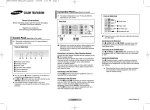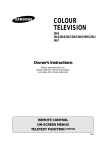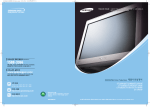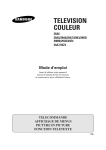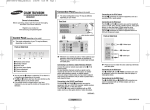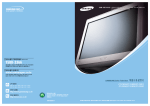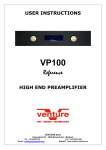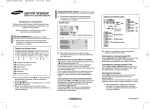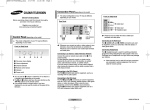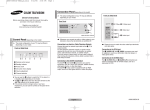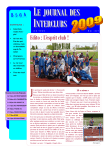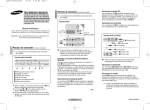Download Samsung CS-29K30MH User Manual
Transcript
AA68-03773A-00Eng_M-asia 5/9/06 10:00 AM Page 1 COLOUR TELEVISION CS21E20/21K10/21K30/21M6/21M20/ 21M21/21L30/25K10/25M6/25M20/25M21/ 29E20/29K10/29K3/29K5/29K30/29L30/ 29M6/29M16/29M20 Connection Panel (depending on the model) ➢ The actual configuration of your TV may be different, depending on your model. Rear Panel Owner’s Instructions Before operating, please read this manual thoroughly, and retain it for future reference. or cable television network Register your product at www.samsung.com/global/register Connecting to the RCA Output The RCA4 connectors are used for equipment, such as a recording VCR or audio system. Connecting to the RCA Input The RCA5 and RCA6 connectors are used for equipment, such as a VCR, DVD, decoder, satellite receiver, video game device, or video disc player. (When using the mono equipment, connect to the AUDIO-L input connector.) The RCA7 connectors are used for equipment such as a DVD with component output (480i, 576i). or Front (or Side) Panel Control Panel (depending on the model) ➢ Audio input The actual configuration of your TV may be different, depending on your model. Video input Headphone jack Front (or Side) Panel ☛ 1 2 3 4 5 6 On-screen menu display Volume adjustment Channel selection Remote control sensor Indicator Power on/off ◆ You can use the 3 buttons to switch the TV on when it is in standby mode depending on the model. ◆ The 2 and 3 buttons also have the same function as the œ/√/†/… buttons on the remote control. ◆ If the remote control no longer works or you have misplaced it, you can use the controls on the panel of the television. Whenever you connect an audio or video system to your television, ensure that all elements are switched off. Please be sure to match the color coded input terminals and cable jacks. Connecting to an Aerial or Cable Television Network Connect the aerial or network input cable to the 1 (75 Ω coaxial socket). To view television channels correctly, a signal must be received by the set from one of the sources: an outdoor aerial, cable television network, or satellite network. If you are using an indoor aerial, you may need to adjust it when tuning your television until you obtain a picture that is both sharp and clear. Connecting to the SCART Input/Output The SCART2 and SCART3 connectors are used for equipment, such as a VCR, DVD, decoder, satellite receiver, video game device, or video disc player. The SCART2 is also used for equipment with an RGB output, such as a video game device or video disc player. ☛ Please be sure to match the colour coded input terminals and cable jacks. Connecting to the RCA Input The 1 (AUDIO-L/R) and 2 (VIDEO) connectors are used for equipment, such as a camcorder, video disc player, or video game device. Connecting Headphones The 3 (headphone) jack is used for watching a television programme without disturbing the other people in the room. Prolonged use of headphones at a high volume may damage your hearing. ➢ When both the front (or side) AV and rear connectors are connected to external equipment, the front (or side) AV receives priority. continued... English - 1 AA68-03773A-00 AA68-03773A-00Eng_M-asia 5/9/06 10:00 AM Page 2 Remote Control (depending on the model) ➢ Operation of remote control may be affected by bright artificial light near to the TV. Switching the Television On and Off 7 MENU Used to display the onscreen menu or return to the previous menu. % P / Used to display the next or previous stored channel. 8 …/†/œ/√ Used to control the cursor in the menu. ^ INFO Used to view the channel information and setting status you selected. 9 P.SIZE Used to change the screen size. ! TURBO Used to select the turbo sound option. @ S.MENU Used to display the sound menu. # PRE-CH Used to switch repeatedly between the last two channels displayed. $ SOURCE Used to display all of the available video sources. 2 Numeric buttons Used to select channels directly. 3 -/-Used to select a channel numbered ten or over. Press this button, then “--” symbol is displayed. Enter the two-digit channel number. 4 MUTE Used to switch the sound off temporarily. To turn the sound back on, press the MUTE, , or button. 5 / Used to increase or decrease the volume. 6 TV Used to return to the TV mode when it is in external input mode. 1 Plug the mains lead into an appropriate socket. ➢ The main voltage is indicated on the rear of the television and the frequency is 50 or 60Hz. 2 Press the television. 3 Press the POWER button on the remote control to switch the television on. The programme that you were watching last is re-selected automatically. If you have not yet stored any channels, no clear picture appears. Refer to “Channel - Auto Store” or “Channel - Manual Store” on page 4. ➢ If the television is initially powered on, several basic customer settings proceed automatically. Refer to “Setup - Plug & Play” on page 3. 4 To switch the television off, press the on the front (or side) of the television. & EXIT Used to exit from any display or return to normal viewing. 0 DUAL I-II Used to select the sound mode. 1 POWER Used to switch the TV on and off. The mains lead is attached to the rear of the television. * ENTER While using the onscreen menus, press the ENTER button to activate (or change) a particular item. button (On/Off) on the front (or side) of the button (On/Off) ( SLEEP Used to select a preset time interval for automatic turn off. ) P.MODE Used to select the picture effect. a S.MODE Used to select the sound effect. Placing the Television in Standby Mode The television can be placed in standby mode, in order to reduce power consumption and wear of the cathode ray tube. Standby mode can be useful when you wish to interrupt viewing temporarily (during a meal, for example). 1 Press the POWER button on the remote control while viewing. The television is in standby mode. 2 To switch the television back on, simply press it again. Installing Batteries Remove the cover. Install two AAA size batteries, then replace the cover. When the remote control does not operate normally, check that the “+” and “-” ends of the batteries are inserted correctly or the batteries are drained. ➢ Do not mix battery types, i.e. alkaline and manganese. English - 2 ☛ Do not leave the television in standby mode for long periods of time (when you are away on holiday, for example). Turn the television off by pressing the button (On/Off) on the front (or side) of the television. It is best to unplug the set from the mains and aerial. AA68-03773A-00Eng_M-asia 5/9/06 10:00 AM Page 3 2 Viewing the Menus 1 he 2 Press the … or † button to select one of the icons. Press the ENTER button to access the icon’s sub-menu. 3 Press the … or † button to move to items in the menu. Press the ENTER button to enter items in the menu. 4 Press the …/†/œ/√ button to change the selected items. Press the MENU button to return to the previous menu. e sic o Press the MENU button. The main menu is displayed on the screen. Its left side has five icons: Input, Picture, Sound, Channel, and Setup. 5 3 4 Press the EXIT button to exit from the menu. 5 ff) Setup - Plug & Play e . It Make sure that the antenna is connected to the television (refer to page 1). Press the ENTER button. The Area menu is displayed. Press the … or † button to select your area. Press the ENTER button. To search the channels, press the ENTER button. To stop the search, press the ENTER button. When the channel searching has finished, the Clock Set menu is displayed. Plug & Play If the television is in standby Start Plug & Play. mode, press the POWER OK button on the remote Enter Return control. The Start Plug & Plug & Play Play. is displayed. To start Language Plug & Play, press the English Français ENTER button. The Türkçe Language menu is displayed. ➢ The Language menu Move Enter Skip will automatically appear after several seconds, even if the ENTER button is not pressed. 6 7 Press the œ or √ button to move to the hour or minute. Set the hour or minute by pressing the … or † button. Re-setting the Plug & Play † Method: MENU ➜ …/† † (Setup) ➜ ENTER ➜ …/† (Plug & Play) ➜ ENTER Setup TV Move Asia/W.Europe CIS/E.Europe China Hong Kong/UK Australia NZL/Indonesia Return Move South Africa America Enter Skip Plug & Play Auto Store Start Enter Skip Plug & Play Auto Store P 1 C-- 102MHz 7 % Stop Skip Plug & Play Clock Set Move --:-- am Enter Skip Input (depending on the model) Source List / Edit Name Source List TV ◆ Source List TV You can switch between AV1 ---viewing signal from AV2 ---Componet - - - connected equipment, such as a VCR, DVD, set-top box, and the TV source Move Enter Return (broadcast or cable). You can change the required external source simply ➢ by pressing the SOURCE button on the remote control. It might take a short period of time for pictures to be switched. To return to the TV mode, press the TV button on the remote control. ◆ Edit Name You can give a name to the external source. Edit Name TV AV1 : ------AV2 : -VCR --Component : -DVD --Cable STB Sat. STB AV Receiver DVD Receiver † Move English - 3 Enter Plug & Play When you have finished, Enjoy your watching. press the MENU button. OK The Enjoy your watching. is displayed, and then the channel which has been stored will be activated. continued... √ √ √ √ √ √ √ Plug & Play Language : English Time Child Lock Blue Screen : Off Melody : On Demonstration Area Enter When the television is initially powered on, several basic customer settings proceed automatically and subsequently. The following settings are available. 1 Select the appropriated language by pressing the … or † button. Press the ENTER button. The Check antenna Plug & Play input. is displayed. Check antenna input. ➢ If any language is not OK selected, the language Enter Skip menu will disappear about 30 seconds later. Enter Return AA68-03773A-00Eng_M-asia 5/9/06 10:00 AM Page 4 Channel - Auto Store Channel - Manual Store Channel - Add/Delete You can scan for the frequency ranges available to you (and availability depends on your country). Automatically allocated programme numbers may not correspond to actual or desired programme numbers. However you can sort numbers manually and clear any channels you do not wish to watch. Manual Store TV You can store channels, Programme : P 3 including those received via Colour System : AUTO √ cable networks. When storing Sound System : BG √ Search : 46MHz channels manually, you can Channel : C 1 Store : ? choose: - Whether or not to store each Move Adjust Return of the channels found - The programme number of each stored channel which you wish to identify Add/Delete TV You can exclude channels you … More have chosen from the channels P 1 : Added you scanned. When you scan P 2 : Added P 3 : Added through the stored channels, P 4 : Added P 5 : Added those you have chosen to skip † More are not displayed. All of the Move Enter Return channels that you did not specifically choose to skip are displayed during scanning. Auto Store Channels are sorted and stored TV Asia/W.Europe Area : Belgie in the order which reflects their CIS/E.Europe Search China position in the frequency range Hong Kong/UK (with lowest first and highest Australia NZL/Indonesia last). The programme originally South Africa America selected is then displayed. Move Enter Return To stop the search before it ➢ has finished, press the Search P 1 C-102MHz ENTER button. 7 % When finished, the Sort menu Stop is displayed. To sort the stored Enter Return channels into the desired numerical order, refer to “Channel - Sort”. To exit without sorting, press the EXIT button. ◆ Programme (Programme number to be assigned to a channel) ◆ Colour System: AUTO/PAL/SECAM/NTSC4.43/NTSC3.58 ◆ Sound System: BG/DK/I/M ◆ Search (When you do not know the channel numbers): The tuner scans the frequency range until the first channel or the channel that you selected is received on the screen. ◆ Channel (When you know the number of the channel to be stored) ➢ You can also select the channel number directly by pressing the numeric buttons (0~9). ◆ Store (When you store the channel and associated programme number) ➢ ☛ Channel - Sort This operation allows you to change the programme numbers of stored channels. This operation may be necessary after using auto store. Sort TV From To Store : P 1 ----: P-- ----: ? ◆ From: Channel number to be changed. ◆ To: New channel number to be identified. ◆ Store: Confirmation the exchange of channel numbers. Move Adjust Return If there is no sound or abnormal sound, re-select the sound standard required. Channel mode ◆ P (Programme mode): When completing tuning, the broadcasting stations in your area have been assigned to position numbers from P00 to P99. You can select a channel by entering the position number in this mode. ◆ C (Real channel mode): You can select a channel by entering the assigned number for each air broadcasting station in this mode. ◆ S (Cable channel mode): You can select a channel by entering the assigned number for each cable channel in this mode. Method: ENTER ➜ …/† ➜ ENTER : Select Added or Deleted. Channel - Fine Tune If the reception is clear, you do not have to fine-tune the channel, as this is done automatically during the search and store operation. If however the signal is weak or distorted, you may have to fine-tune the channel manually. Fine Tune Method: œ/√ : You can obtain a sharp P 1 and clear picture and good Reset sound quality. Move …/† ➜ ENTER : You can reset Adjust Return the setting. MENU : You can memorise adjusted picture or sound. 0 Channel - LNA (depending on the model) This function is very useful in the situation that the TV is used in weak signal. LNA amplifies the TV signal in the weak signal area, but not noise. Channel TV Auto Store Manual Store Add/Delete Fine Tune Name Sort LNA Move Enter : Off On Return ◆ LNA (Low Noise Amplifier) setting is to be made for each channel. ◆ If the picture is noisy with the LNA set to On, select Off. ◆ Depending on areas, factory mode of LNA will be set up as On or Off. English - 4 te turn nd 0 el AA68-03773A-00Eng_M-asia 5/9/06 10:29 AM Page 5 Channel - Name Channel names will be assigned automatically when channel information is broadcast. These names can be changed, allowing you to assign new names. Name TV … More P 1 : ----P 2 : ----P 3 : ----P 4 : ----P 5 : ----† More Move ◆ On Timer Volume The preferred volume can be set for when the timer automatically turns on the television. Enter Method: …/† : Used to select a letter or number. œ/√ : Used to move to the previous or next letter. ENTER : Used to confirm the new name. Return f. p ☛ Auto Power Off When you set the timer “On”, the TV will eventually turn off, ifno controls are operated for 3 hours after the TV was turned on by timer. This function is only available in timer “On” mode and prevents overheating, which may occur if a TV is on for too long. Setup Language / Blue Screen / Melody / Demonstration ◆ Language It is variable depending on the model. When you start using the television for the first time, you must select the language which will be used for displaying menus and indications. Setup TV √ √ √ √ √ √ √ Plug & Play Language : English Time Child Lock Blue Screen : Off Melody : On Demonstration Move Enter Exit ◆ Blue Screen If no signal is being received or the signal is very weak, a blue screen automatically replaces the noisy picture background. If you wish to continue viewing the poor picture, you must set the Blue Screen to Off. Setup - Time ◆ Clock - - : - - am Clock You can set the television Sleep Timer : Off √ clock so that the current time On Timer - - : - - am Off Off Timer - - : - - am Off is displayed when pressing On Timer Channel : P 1 On Timer Volume : 10 the INFO button on the remote control. You must Move Enter Return also set the time if you wish to use the automatic on or off timers. ➢ When pressing the button (On/Off) on the front (or side) of the television, the clock setting will be reset. TV ◆ Melody You can hear melody sound when the television is powered on or off. Time ◆ Sleep Timer You can select a time period of between 30 and 180 minutes after which the television automatically switches to standby mode. ➢ You can select these options simply by pressing the SLEEP button on the remote control. If the sleep timer is not yet set, Off is displayed. If it is already set, the remaining time before which the television switches to standby mode is displayed. turn for ◆ On Timer Channel The preferred channel can be set for when the timer automatically turns on the television. ◆ On Timer / Off Timer You can set the On/Off timers so that the television will switch on or off automatically at the time you select. ☛ You must set the clock first. Setup - Child Lock Child Lock TV This feature allows you to Child Lock : On √ prevent unauthorized users, Programme : P 1 such as children, from watching Lock : ? unsuitable programmes by muting out video and audio. Child Lock cannot be released Move Enter Return using front (or side) panel buttons. Only remote control can release the Child Lock setting, so keep the remote control away from children. ◆ Child Lock: Off/On If you want to unlock a channel, set to Off. ◆ Programme: Channel number to be locked. ◆ Lock: When press the ENTER button, the Locked is displayed. ➢ If any channel is locked, you can not access to the Channel and Child Lock menu by using the control buttons on the TV panel (the Not Available is displayed in the Child Lock menu). You can access by using the remote control only. continued... English - 5 ◆ Demonstration To become familiar with the various menus provided by the television, you can view the in built demonstration. Each of the menu options is displayed in turn. To exit from the demonstration, press the EXIT button. AA68-03773A-00Eng_M-asia 5/9/06 10:00 AM Page 6 Picture - Mode Mode TV ◆ Mode: Dynamic/ Mode : Dynamic √ Standard/Movie/Custom Contrast : 100 Brightness : 50 You can select the type of Sharpness : 75 picture which best Color : 50 Tint : G 50 R 50 corresponds to your viewing Color Tone : Cool1 √ Reset √ requirements. Move Enter Return You can select these ➢ options simply by pressing the P.MODE button on the remote control. ◆ DNIe Jr (Digital Natural Image engine Junior) (depending on the model) This feature bring you more detailed image with detail enhancement, contrast enhancement and white enhancement. New image compensation algorithm gives brighter, clearer, much detailed image to you. DNIe Jr technology will fit every signals into your eyes. ◆ Tilt (depending on the model) If you find that the picture received is slightly tilted to one side, you can adjust the tilt setting (-7 to +7). ◆ Contrast/Brightness/Sharpness/Color/ Tint(NTSC only) The television has several settings which allow you to control the picture quality. ◆ Color Tone: ◆ Swap You can interchange the main picture and sub-picture. 3 ◆ Size: Large/Small You can select a size of the sub-picture. 4 ◆ Position: / / / You can select a position of the sub-picture. 5 ◆ Programme You can select a channel of the sub-picture only when the Source is set to TV. 6 Easy functions of the remote control You can freeze the sub-picture. Cool2/Cool1/Normal/Warm1/ Warm2 ◆ Reset You can return to the factory defaults. The reset function is set for each mode (Dynamic, Standard, Movie, or Custom). Picture - PIP (depending on the model) You can display a sub picture within the main picture of TV programme or external A/V devices such as VCR or DVD. In this way you can watch TV program or monitor the video input from any connected devices while watching TV or other video input. Picture TV Picture Size / Digital NR / DNIe Jr / Tilt Mode : Dynamic √ Size : Normal √ Digital NR : Off √ DNIe Jr : On √ Tilt : 0 PIP √ Picture TV ◆ Size (depending on the Mode : Dynamic √ model) Size : Normal √ You can select the picture Digital NR : Off √ DNIe Jr : On √ size which best corresponds Tilt : 0 PIP √ to your viewing requirements. It is variable Move Enter Exit depending on the model. ➢ You can change the picture size simply by pressing the P.SIZE button on the remote control. ◆ Digital NR If the signal received by the television is weak, you can activate this feature to reduce any static and ghosting that may appear on the screen. Move Enter Return PIP TV PIP Source Swap Size Position Programme Move : On : TV : Large : : P 1 Enter √ √ √ √ √ Return ◆ PIP: Off/On You can activate or deactivate the PIP funtion. 1 ◆ Source You can select a source of the sub-picture. 2 ➢ Depending on the models, the sub-picture can be viewed only when a source different from the main picture's is selected. If a TV programme is viewed on the main picture, the sub-picture is not available for TV programmes. If a TV source is selected, the message Not Available is displayed. continued... continued... English - 6 Sound Mode / Equalizer / Auto Volume / Pseudo Stereo / Turbo Plus Sound TV ◆ Mode: Standard/Music Mode : Standard √ /Movie/Speech/Custom Equalizer √ You can select the type of Auto Volume : Off √ Pseudo Stereo : Off √ special sound effect to be Turbo Plus : Off √ used when watching a given broadcast. Move Enter Exit ➢ You can select these options simply by pressing the S.MODE button on the remote control. continued... AA68-03773A-00Eng_M-asia 3 5/9/06 10:00 AM Page 7 ◆ Equalizer The television has several settings which allow you to control the sound quality. ➢ If you make any changes to these settings, the sound mode is automatically switched to Custom. ◆ Auto Volume Each broadcasting station has its own signal conditions, and so it is not easy to adjust the volume every time the channel is changed. This feature lets you automatically adjust the volume of the desired channel by lowering the sound output when the modulation signal is high or by raising the sound output when the modulation signal is low. Teletext Feature (depending on the model) Most television stations provide written information services via teletext. The index page of the teletext service gives you information on how to use the service. In addition, you can select various options to suit your requirements by using the remote control buttons. ☛ For teletext information to be displayed correctly, channel reception must be stable. Otherwise, information may be missing or some pages may not be displayed. ◆ Pseudo Stereo This feature converts a monaural sound signal into two identical left and right channels. Once the Pseudo Stereo is set to On or Off, these settings apply to the sound effects such as Standard, Music, Movie, and Speech. ◆ Turbo Plus This feature suitably emphasizes both higher and lower bands of sound (and includes other effects). You can enjoy more magnificent and dynamic sound when watching music, movie, or other channels. ➢ You can change the options simply by pressing the TURBO button on the remote control. 1 (hold) Used to hold the display on a given page if the selected page is linked with several secondary pages which follow on automatically. To resume, press it again. 2 (index) Used to display the index (contents) page at any time while you are viewing teletext. nd √ √ √ √ √ it n d... English - 7 3 (sub-page) Used to display the available sub-page. 4 (teletext on/mix) Press to activate teletext mode after selecting the channel providing the teletext service. Press it again to overlap the teletext with the current broadcasting screen. 5 Coloured buttons (red/green/yellow/blue) If the FASTEXT system is used by a broadcasting company, the different topics covered on a teletext page are colour-coded and can be selected by pressing the coloured buttons. Press one of them corresponding to the required. The page is displayed with other coloured information that can be selected in the same way. To display the previous or next page, press the corresponding coloured button. 6 (page up) Used to display the next teletext page. 7 (mode) Press to select the teletext mode (LIST/FLOF). If you press it in the LIST mode, it switches into the List save mode. In the List save mode, you can save teletext page into list using the (store) button. 8 (page down) Used to display the previous teletext page. 9 (reveal) Used to display the hidden text (answers to quiz games, for example). To display normal screen, press it again. 0 (size) Press to display the double-size letters in the upper half of the screen. For lower half of the screen, press it again. To display normal screen, press it once again. ! (store) Used to store the teletext pages. AA68-03773A-00Eng_M-asia 5/9/06 10:00 AM Page 8 Troubleshooting Before contacting the Samsung after-sales service, perform the following simple checks. If you cannot solve the problem using the instructions below, note the model and serial number of the television and contact your local dealer. OSD Map Input Picture No sound or picture ◆ Check that the mains lead has been connected to a wall socket. ◆ Check that you have pressed the button (On/Off) and the POWER button. ◆ Check the picture contrast and brightness settings. ◆ Check the volume. Normal picture but no sound ◆ Check the volume. ◆ Check whether the volume MUTE button on the remote control has been pressed. ✽ : It is variable depending on the model. - Source List ✽ - Edit Name - Mode - Size ✽ Digital NR DNIe Jr ✽ Tilt ✽ PIP ✽ - Mode Equalizer Auto Volume Pseudo Stereo Turbo Plus No picture or black and white picture ◆ Adjust the colour settings. ◆ Check that the broadcast system selected is correct. Sound and picture interference ◆ Try to identify the electrical appliance that is affecting the television, then move it further away. ◆ Plug the television into a different mains socket. Blurred or snowy picture, distorted sound ◆ Check the direction, location and connections of your aerial. This interference often occurs due to the use of an indoor aerial. Sound Channel - Auto Store - Manual Store Remote control malfunctions ◆ Replace the remote control batteries. ◆ Clean the upper edge of the remote control (transmission window). ◆ Check that the “+” and “-” ends of the batteries are inserted correctly. ◆ Check that the batteries are drained. Setup Add/Delete Fine Tune Name Sort LNA ✽ - Plug & Play - Language ✽ - Time - Child Lock Blue Screen Melody Demonstration English - 8 - VCR / DVD / Cable STB / Sat. STB / AV Receiver / DVD Receiver / Game / Camcorder / DVD Combo - Dynamic / Standard / Movie / Custom Contrast Brightness Sharpness Color Tint (NTSC only) Color Tone - Cool2 / Cool1 / Normal / Warm1 / Warm2 Reset - Off / On - Off / On - PIP Source ✽ Swap Size Position Programme - Off / On - Standard / Music / Movie / Speech / Custom - Off / On - Off / On - Off / On - Area ✽ - Search Programme Colour System ✽ - AUTO / PAL / SECAM / NTSC4.43 / NTSC3.58 Sound System ✽ - BG / DK / I / M Search Channel Store - Off / On - - Asia/W.Europe / CIS/E.Europe / China / Hong Kong/UK / Australia / NZL/Indonesia / South Africa / America Clock Sleep Timer On Timer Off Timer On Timer Channel On Timer Volume Off / On Off / On Off / On









